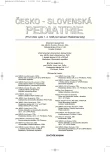-
Medical journals
- Contact
The Diet Structure of 11-years Old Children – the ELSPAC Study
Authors: J. Fiala 1; L. Kukla 2; K. Poslušná 1
Authors‘ workplace: Ústav preventivního lékařství, Lékařská fakulta, Masarykova univerzita, Brno vedoucí prof. MUDr. Z. Brázdová, DrSc. 1; II. dětská klinika LF MU a FN, Brno přednosta prof. MUDr. Z. Doležel, CSc. 2
Published in: Čes-slov Pediat 2008; 63 (9): 481-490.
Category: Original Papers
Overview
The study objective:
The described research was performed within the ELSPAC project, which aims to study in a longitudinal manner a wide variety of child growth determinants, mainly environmental, family, life-style and social factors. The goal of this part is to give basic descriptive nutritional characteristics, especially which concern the nutrition structure based on data acquired from the ELSPAC study sample at the age of eleven.Methods:
The data was acquired by administering standard ELSPAC questionnaires to participating families in Brno. The nutrition information was obtained from a questionnaire about the child filled by the mother. Altogether 2151 complete reports were elaborated.Results:
The main foodstuff groups consumption assessment based on average frequency has shown a low frequency of cereals, vegetables and fruits while consumption was high in the milk, meat and „other“ groups. A closer look on the group inner structure has shown in some cases very unfavorable representation, for example a dominant ratio of smoked and processed meats in the meat group or similarly the ratio of biscuits and wafers in the cereal group. The consumption frequency distribution in the sample has then shown further significant shortcomings, for example only 24% of children have fresh vegetables daily and 34% 1–2 times a week at a maximum. Daily fruit consumption is reported only in 50% of children. 58% take milk and dairy products (not including curds and cheeses) daily, and curd and cheeses 39%. But 14% take milk and dairy products 1–2 times a week at a maximum and 19% curd and cheeses 1–2 times a week at a maximum.Conclusions:
The results have pointed out significant shortcomings in the main foodstuff group representation when some report insufficient consumption while others too high. The importance of nutrition in childhood for health in adulthood is emphasized. The study has also shown the importance of evaluation type, for example average frequencies versus their distribution in the study sample.Key words:
nutrition, diet structure, foodstuff groups, 11-year-old children, ELSPAC
Sources
1. http://www.med.muni.cz/elspac/.
2. Kukla L, Hrubá D, Tyrlík M. Některé aspekty rodinného prostředí českých dětí. Výsledky studie ELSPAC. Čes.-slov. Pediat. 2006;61(6): 502–505.
3. Brázdová Z, Fiala J. Dietary Guidelines in the Czech Republic. Acta Facultatis Medicae Universitatis Brunensis Masarykianae, sv. 115. Brno, 1998 : 247. ISBN 80-210-1956-5.
4. Mullerová D, Aujezdská A, Muller L. Výživové zvyklosti dětí mladšího školního věku ve městě Plzeň. Čes.-slov. Pediat. 2006;61(9): 502–505.
5. Čeřovská J, Bílek R, Dvořáková M, et al. Změny v zásobení jódem po eradikaci jódového deficitu a jejich možné příčiny. Randomizovaná studie dětské populace dvou regionů České republiky s odstupem 5 let. Čes.-slov. Pediat. 2007;62(2): 65–72.
6. Parizkova J. Dietary habits and nutritional status in adolescents in Central and Eastern Europe: Eur. J. Clin. Nutr. 2000;54(Suppl 1): 36–40.
7. Aranceta Bartrina J, Serra-Majem L, Pérez-Rodrigo C, et al. Nutrition risk in the child and adolescent population of the Basque country: the enKid Study. Br. J. Nutr. 2006;96(Suppl 1): 58–66.
8. Talvia S, Rasanen L, Lagstrom H, et al. Longitudinal trends in consumption of vegetables and fruit in Finnish children in an atherosclerosis prevention study (STRIP). Eur. J. Clin. Nutr. 2006;60(2): 172–180.
9. Vereecken CA, DeHenauw S, Maes L. Adolescents’ food habits: results of the health behaviour in school-aged children survey. Br. J. Nutr. 2005;94 : 423–431.
10. Wolf A, Yngve A, Elmadfa I, et al. Fruit and vegetable intake of mothers of 11-year-old children in nine European countries: The Pro Children Cross-sectional Survey. Ann. Nutr. Metab. 2005;49(4): 246–254.
11. AHA (American Heart Association). Dietary recommendations for children and adolescents: A guide for practitioners. Pediatrics 2006;117(2): 544–559.
12. Manyard M, Gunnell D, Ness AR, et al. What influences diet in early old age? Prospective and cross-sectional analyses of the Boyd Orr cohort. European Journal of Public Health 2005;16(3): 315–323.
13. Hayman LL, Meininger JC, Daniels SR, et al. Primary prevention of cardiovascular diseases in nursing practice: Focus on children and youth. Circulation 2007;116 : 344–357.
14. Tercak KP, Tyc VL. Opportunities and challenges in the prevention and control of cancer and other chronic diseases: children’s diet and nutrition and weight and physical activity. J. Pediatr. Psychol. 2006;31(8): 750–763.
15. Uauy R, Solomons N. Diet, nutrition and the life-course approach to cancer prevention. J. Nutr. 2005;135(12 Suppl): 2934–2945.
Labels
Neonatology Paediatrics General practitioner for children and adolescents
Article was published inCzech-Slovak Pediatrics

2008 Issue 9-
All articles in this issue
- Communication with the Patient as One of the Compliance Key Roles
- The Risk of Accepting New Standard of the World Health Organization for Evaluating Growth of the Czech Child Population (0–5 years of age)
- Contribution to Liver Disorders in Childhood – Analysis of the Histological Findings in 100 Core Needle Biopsies
- The Diet Structure of 11-years Old Children – the ELSPAC Study
- Suckling Colics
- Compliance in Chronic Diseases in the Adolescence Period
- Recommended Procedure for Prevention and Therapy of Child Obesity
- Czech-Slovak Pediatrics
- Journal archive
- Current issue
- Online only
- About the journal
Most read in this issue- Contribution to Liver Disorders in Childhood – Analysis of the Histological Findings in 100 Core Needle Biopsies
- Suckling Colics
- Recommended Procedure for Prevention and Therapy of Child Obesity
- The Risk of Accepting New Standard of the World Health Organization for Evaluating Growth of the Czech Child Population (0–5 years of age)
Login#ADS_BOTTOM_SCRIPTS#Forgotten passwordEnter the email address that you registered with. We will send you instructions on how to set a new password.
- Contact

